Gymnastics tradition in Finland
| Gymnastics tradition in Finland | ||||
|---|---|---|---|---|
| In the national inventory | ||||
|
Practitioners and people who know the tradition well
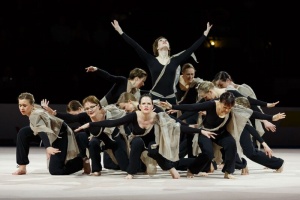
Aesthetic group gymnastics and flow gymnastics have been developed based on traditional Finnish gymnastics. Traditional Finnish gymnastics is known for its large-scale group performances – straight lines, precise movement and an admirable level of coordination. Finnish mass performances enjoy international recognition and remain unparalleled.
Flow gymnastics is a hobby for girls and women of all ages. In 2016, approximately 7,500 people were taking part in flow gymnastics as a hobby. Flow gymnastics is suitable for those interested in regular competitions and performances and it also has a fitness version intended for adults. Flow gymnastics has its own competition system. Various gymnastics shows and events both at home and abroad provide opportunities to perform.
Aesthetic group gymnastics is the biggest of the competitive forms of gymnastics in Finland. This discipline has several skill levels from amateur gymnastics to high performance sports. Finland has won ten world championships and is one of the top countries in the sport. In 2016, aesthetic group gymnastics was available as a hobby at 172 gymnastics clubs. During the season of 2015–2016, a total of 3,834 licensed athletes and approximately 7,700 amateur athletes were involved in the discipline. In Finland, aesthetic group gymnastics is only practised by girls and women, but in some parts of the world, boys and men have also joined in.
Gymnastics is a popular hobby. The Finnish Gymnastics Federation consists of 374 gymnastics clubs with a total of approximately 123,000 members. The Finnish Gymnastics Federation is one of the biggest sports federations in Finland and the largest sports organisation getting girls and women moving.
Practising of the tradition
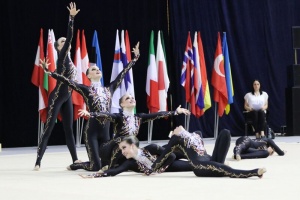
These days, aesthetic group gymnastics is a widespread sport and an international competitive sport. It is characterised by smoothly transitioning body movements and expressiveness, and at best a competition performance is like art, following the nuances of the selected piece of music. Aesthetic group gymnastics is the biggest competitive discipline in the Finnish Gymnastics Federation. The Aesthetic Group Gymnastics World Championships have been organised annually since 2000. Finland is among the top countries in aesthetic group gymnastics, and Finns have won more than ten world championship medals, most of them gold.
In aesthetic group gymnastics, the programme is a balanced combination of movement, music, costumes, expressions, athleticism, atmosphere and a theme. The content and progress of the programme are strictly defined by both national and international rules. From the athletes, this discipline requires balance, mobility, strength and coordination. A sense of rhythm and expressiveness are also important, because the competition programmes build a story around the music.
Flow gymnastics is based on traditional Finnish gymnastics, similarly to aesthetic group gymnastics. It is a full-body sport, in which the movements originate from the core, flow seamlessly and are rhythmically, aesthetically, creatively and expressively reflected by the entire body. In addition to possessing the sport-specific technique, the athlete must be physically fit and have strength, mobility, a good sense of balance and coordination.
Flow gymnastics programmes also require expressiveness and the ability to convey emotion from the competitors/performers, so it is important to do exercises that develop these skills in addition to the actual technique. Flow gymnastics offers athletes opportunities and challenges to create a variety of programme styles – the free flow of creativity and the possibilities provided by different types of music and themes are almost endless!
Athletes may use gymnastics apparatuses or their own props for training and performances if they wish. Mass performances have always been part of large-scale gymnastics events held in Finland. These performances have been created for athletes of all ages, from children to seniors. The large group performances have also been introduced abroad at the massive Gymnaestrada events held every four years.
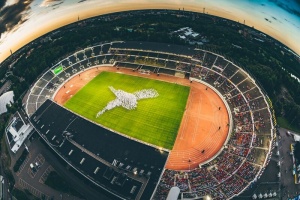
Nowadays, the choreographies of large group performances range from basic to more advanced. A single programme may also contain simple and more challenging roles, allowing people of varying skill levels to participate. In addition to movement variations, the programmes can be made more difficult by adding changing geometric patterns and fast-paced transitions. The main focus in large group performances is always on the large number of gymnasts. A simple movement combined with changing patterns looks impressive when performed by 600 people simultaneously to music.
The Gymnaestrada gymnastics festival held in Helsinki in summer 2015 was the largest sports event ever organised in Finland in terms of the number of international participants. At Helsinki’s Gymnaestrada, the audience was delighted by performances such as the Swan, performed by 800 Finnish gymnasts. This choreography was designed by Riikka Virkajärvi-Johnson.
Helsinki also wrote a new chapter in the large group gymnastics history: for the first time ever, the event included an international routine called From Near or Far – Come as You Are! This routine was performed by over 2,000 gymnasts from 33 countries from every continent. The choreography of this international large group performance was created by Finnish Marja Kallioniemi and Hannele Ahlqvist.
After Helsinki’s Gymnaestrada, the Swan performance was also booked to be performed at the gymnastics mass event in Germany, Turnfest. More than 500 women from Finland travelled to Germany to perform the Swan routine at Turnfest’s Stadion Gala in June 2017.
The background and history of the tradition
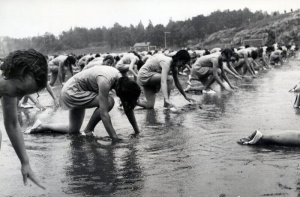
Traditional Finnish gymnastics has a long history. The first women’s gymnastics club, Gymnastikföreningen för Fruntimmer i Helsingfors, was founded in 1876, only a year after the foundation of the first men’s gymnastics club. The founders of the women’s club included Elin Waenerberg (later Kallio) and Betty Sahlsten. Elin Kallio (1859–1927) is considered the mother of traditional Finnish gymnastics, and she had a significant role in the development of the sport. Six years after the club was founded, Kallio took part in organising Finland’s first women’s gymnastics show, and she also arranged the first female gymnasts’ trip abroad to Stockholm in 1891.
The turn of the century was a time of launching and practising the running of gymnastics clubs and federations. In accordance with the zeitgeist of the period, sports was a means to promote public health and educate the people, as well as to promote women’s emancipation and national independence. Finland’s first federation for sports, the Women's Gymnastics Federation of Finland (Suomen Naisvoimisteluliitto, Finska Kvinnors Gymnastikförbund) was founded in 1896, with Elin Kallio leading the project, and for the following years, the federation was in charge of several large sports festivals.
Other strong female figures who took part in developing traditional Finnish gymnastics include the University of Helsinki’s Gymnastics Department lecturers Hilma Jalkanen and Elna Kopponen, as well as gymnastics instructor and physician Kaarina Kari.
The skills of Finnish gymnasts have also been exhibited at three Olympic Games. The first one of these was in Stockholm in 1912, where Finland had a women’s gymnastics team consisting of 25 athletes. In Berlin in 1936, the stage was simultaneously occupied by 206 female gymnasts, and at Helsinki’s Games in 1952, the Finnish team consisted of 675 gymnasts from four clubs.
Previously, competitions had typically been avoided in women’s gymnastics, but in the 1950s, the number of competitions and their popularity began to increase. The traditional principles associated with women’s gymnastics – the importance of hobbies, equality and spending time with others – remained intact, despite the competitions.
Since 1953, Finnish girls and women have performed many traditional Finnish gymnastics routines at the international Gymnaestrada events, and through the performances, the joy of doing sports and the community spirit have been communicated to the audiences. Finns have participated in all of the Gymnaestradas, performing large group performances on fields, group routines in halls, at evening shows and on urban stages.
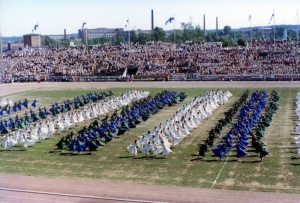
Raija Riikkala’s famous Finnish Summer large group programme was performed at the Finnish Festival Games of 1980. The programme used music by Jean Sibelius, and the athletes wore long, wide and wavy skirts as their ‘apparatus’. At the end of the programme, the gymnasts formed a fluttering Finnish flag. This field programme was performed as a hall version in 1982 at the Gymnaestrada in Zürich, and again as a large-scale field performance at the first World Championships in Athletics in 1983 in Helsinki.
In 1995, Finland presented the international field of gymnastics with a new sport, aesthetic group gymnastics, at the Berlin Gymnaestrada. The gymnastics organisations decided to begin organising international invitation competitions annually. The first of these was held in Helsinki in 1996. The first World Championships in Aesthetic Group Gymnastics were held in Helsinki in 2000, and the winner was Team Campuksen Koonto from Jyväskylä, Finland. The International Federation of Aesthetic Group Gymnastics (IFAGG) was founded in 2003. In 2006, the World Championships were held in Tampere, Finland, during the SunSvoli event. Finland won again, and this time it was Team Dynamot from Olarin Voimistelijat. This team has won the most world championships out of all Finnish teams (four gold medals). In 2013, the World Championships were held in Lahti, Finland, during the SunLahti event. In 2015, Finland became the world champion again. In 2016, the first European Championships in Aesthetic Group Gymnastics were held in Tartu, Estonia. Team Minetit from Tampere won the first ever European Championships of this sport.
The transmission of the tradition
Gymnastics clubs offer flow gymnastics and aesthetic group gymnastics. In both disciplines, professional instructors who have a passion for their sport hold the main role in promoting the popularity of flow gymnastics and aesthetic group gymnastics. The aim is to develop the sport’s activities and rules in cooperation with the developmental working group for flow gymnastics and the Finnish Gymnastics Federation.
Aesthetic group gymnastics is a well-established sport in Finland and a popular hobby. In addition to the professional training with long-term goals provided by gymnastics clubs, the sport is being further developed in Finland by an expert group on the sport. The task of this expert group is to develop the sport and promote, guide, monitor and assess the development process, based on the vision and strategy of the Finnish Gymnastics Federation.
The large group performance tradition is upheld by the Finnish Gymnastics Federation at large-scale national and international gymnastics events, which offer a chance to participate in mass joint performances of hundreds of gymnasts. The Finnish Gymnastics Federation commissions large group performance choreographies suitable for athletes and amateurs of all ages from a number of different choreographers for these national and international events. In addition to choreographies for children and young people, there are performances for those who do the sport to increase their fitness level and for adults of various skill levels. The Finnish Gymnastics Federation organises courses on the large group performance programmes so that the instructors from gymnastics clubs can learn the roles and movements of the programme with the choreographer in order to then pass on what they have learnt to the members of their clubs.
Before these large-scale events, the Finnish Gymnastics Federation organises shared rehearsals for all participants, and at these rehearsals, the hundreds of athletes and amateur gymnasts meet for the first time, gathering at the same field to perform the programme as one big group. Gymnastics clubs and instructors have an important role in preserving the Finnish large group gymnastics tradition and passing it on to younger generations.
The future of the tradition
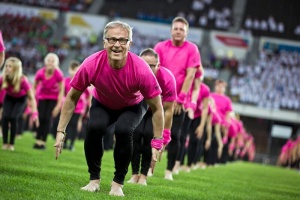
The future looks bright for gymnastics. Thanks to the strong training tradition in aesthetic group gymnastics, Finnish teams will continue to achieve international success generation after generation. The World Championships in Aesthetic Group Gymnastics at Helsinki Ice Hall on 26–28 May 2017 provided thousands of spectators and friends of the sport with excitement and entertainment.
The sport of flow gymnastics is also being developed further. Athletes around Finland feel passionate about the discipline, and the renewed competition system will facilitate growth and development of the sport. Flow gymnastics is a hobby that offers performance opportunities at various shows and attracts people of all ages and skill levels.
It is important to maintain the tradition of Finnish large group performances. Because Finnish gymnasts have shown great interest in group performances and large-scale gymnastics events, the Finnish Gymnastics Federation will be organising large national gymnastics events every four years in the future. The next large gymnastics event the Finnish National Gymnaestrada will be held in Turku on 7–10 June 2018. Approximately 10,000 amateur gymnasts are expected at the event to perform and compete in festival spirit. Large national gymnastics events will be held one year prior to the international Gymnaestrada festivals, allowing the Finnish event to function as the ‘dress rehearsal’ for the international event. The same large group performance programmes will also be performed at large international events. The next international Gymnaestrada, enabling large group performances, will be held in 2019 in Dornbirn, Austria. Finland is once again expected to send one of the largest delegations to Austria. The large international gymnastics events are managed either by the European Union of Gymnastics (UEG) or the International Gymnastics Federation (FIG).
The community behind this submission
The Finnish Gymnastics Federation
Bibliography and links to external sources of information
Videos
- Team Dynamo from Olari Gymnastics became World Champions in Aesthetic Group Gymnastics in 2006
- Finland's Ovo Team in World Championships in Lahti in 2013
- Minettis from Tampere Gymnastics became World Champions in 2015
- Minettis from Tampere Gymnastics became European Champions in 2016
- White Swan - field programme
- ”From near or Far – Come as you are!” - field programme.
Weblinks
- Tietoa lajiasiantuntijaryhmästä
- Aesthetic Group Gymnastics' World Chamionships in 2017
- Website of Finland's Gymnaestrada
- Website of International Gymnaestrada
- Sports history - blog: The beginning of Finnish womens gymnastics
- Finnish Gymnastic Federation's newsroom: Historical moments in the Olympic Stadium(15.7.2015)
- The website of Finnish Gymnastics Federation
- The Finnish Broadcasting Company Yle News 13.8.2007: The tradition of World Championships in track and field begun in Helsinki in 1983
- The Finnish Broadcasting Company Yle News 23.9.2010: Womens Gymnastics in the 1950s
Literature
- The Finnish Gymnastics Federation's annual report 2016
- Sarje, Aino: Lightness and strength, Multiprint 2013 Kleemola, Irja & Kari Kaarina 1988: Whole life of sports, WSOY.
- On the footsteps of Finnish womens gymnastics, University of Jyväskylä's department of sports social sciences, researches 1/2003.
- Vasunta, Marjukka 1987: Rhythm and sports, motion rhythmical basic- and advanced education. WSOY.
